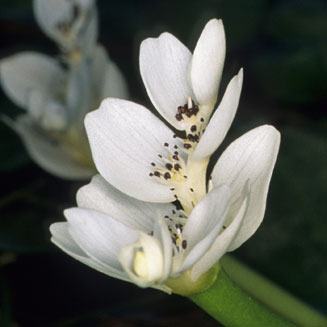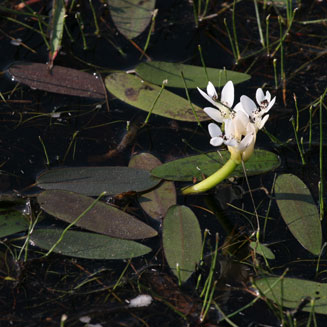|
Aponogeton distachyos (Cape pondweed)
Waterblommetjies [Afrikaans]
Life > eukaryotes > Archaeoplastida > Chloroplastida > Charophyta > Streptophytina > Plantae (land plants) > Tracheophyta (vascular plants) > Euphyllophyta > Lignophyta (woody plants) > Spermatophyta (seed plants) > Angiospermae (flowering plants) > Monocotyledons > Order: Alismatales > Family: Aponogetonaceae > Genus: Aponogeton
 |
 |
| Aponogeton distachyos,
Kogelberg Biosphere Reserve, Kleinmond, Western Cape, South Africa. [photos
H.G.
Robertson, Iziko ©] |
Cape pondweed is an aquatic plant endemic to the Western Cape
that has white flowers that are harvested and eaten as a vegetable. The flowers
are the main ingredient in "waterblommetjie bredie", and are also pickled,
used in salads, soups, or steamed and eaten as a cooked vegetable.
Cape pondweed is endemic to the Western Cape, South Africa.
It is an aquatic plant that grows in standing or slow-moving water. It has
elongate-oval leaves that float on the plant surface and have long stalks
(petioles) going down to rhizomes growing in sediment and soil at the bottom of
the vlei or dam. It bears pretty white flowers and it is these that are
harvested and eaten as a vegetable. Harvesting has become a commercial
undertaking and waterblommetjies can even be bought in tins. They are the main
ingredient in "waterblommetjie bredie", which is a mutton stew with
waterblommetjies added (plus various other ingredients). They are also pickled,
used in salads, soups or, steamed and eaten as a cooked vegetable.
Publications
-
van Wyk, B.-E. 2005. Food Plants of the World -
Identification, Culinary Uses and Nutritional Value. Briza, Pretoria.
|
